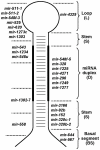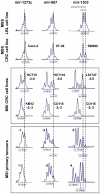MiRNA genes constitute new targets for microsatellite instability in colorectal cancer
- PMID: 22348132
- PMCID: PMC3279428
- DOI: 10.1371/journal.pone.0031862
MiRNA genes constitute new targets for microsatellite instability in colorectal cancer
Abstract
Mismatch repair-deficient colorectal cancers (CRC) display widespread instability at DNA microsatellite sequences (MSI). Although MSI has been reported to commonly occur at coding repeats, leading to alterations in the function of a number of genes encoding cancer-related proteins, nothing is known about the putative impact of this process on non-coding microRNAs. In miRbase V15, we identified very few human microRNA genes with mono- or di-nucleotide repeats (n = 27). A mutational analysis of these sequences in a large series of MSI CRC cell lines and primary tumors underscored instability in 15 of the 24 microRNA genes successfully studied at variable frequencies ranging from 2.5% to 100%. Following a maximum likelihood statistical method, microRNA genes were separated into two groups that differed significantly in their mutation frequencies and in their tendency to represent mutations that may or may not be under selective pressures during MSI tumoral progression. The first group included 21 genes that displayed no or few mutations in CRC. The second group contained three genes, i.e., hsa-mir-1273c, hsa-mir-1303 and hsa-mir-567, with frequent (≥ 80%) and sometimes bi-allelic mutations in MSI tumors. For the only one expressed in colonic tissues, hsa-mir-1303, no direct link was found between the presence or not of mono- or bi-allelic alterations and the levels of mature miR expression in MSI cell lines, as determined by sequencing and quantitative PCR respectively. Overall, our results provide evidence that DNA repeats contained in human miRNA genes are relatively rare and preserved from mutations due to MSI in MMR-deficient cancer cells. Functional studies are now required to conclude whether mutated miRNAs, and especially the miR-1303, might have a role in MSI tumorigenesis.
Conflict of interest statement
Figures





Similar articles
-
Microsatellite instability: an update.Arch Toxicol. 2015 Jun;89(6):899-921. doi: 10.1007/s00204-015-1474-0. Epub 2015 Feb 22. Arch Toxicol. 2015. PMID: 25701956 Review.
-
Interrelationship between microsatellite instability and microRNA in gastrointestinal cancer.World J Gastroenterol. 2012 Jun 14;18(22):2745-55. doi: 10.3748/wjg.v18.i22.2745. World J Gastroenterol. 2012. PMID: 22719182 Free PMC article. Review.
-
Identification of Positively and Negatively Selected Driver Gene Mutations Associated With Colorectal Cancer With Microsatellite Instability.Cell Mol Gastroenterol Hepatol. 2018 Jun 13;6(3):277-300. doi: 10.1016/j.jcmgh.2018.06.002. eCollection 2018. Cell Mol Gastroenterol Hepatol. 2018. PMID: 30116770 Free PMC article.
-
Evolution of instability at coding and non-coding repeat sequences in human MSI-H colorectal cancers.Hum Mol Genet. 2001 Mar 1;10(5):513-8. doi: 10.1093/hmg/10.5.513. Hum Mol Genet. 2001. PMID: 11181575
-
Overexpression of microRNAs-155 and 21 targeting mismatch repair proteins in inflammatory bowel diseases.Carcinogenesis. 2013 Apr;34(4):828-34. doi: 10.1093/carcin/bgs408. Epub 2013 Jan 3. Carcinogenesis. 2013. PMID: 23288924
Cited by
-
MicroRNA-567 inhibits cell proliferation and induces cell apoptosis in A549 NSCLC cells by regulating cyclin-dependent kinase 8.Saudi J Biol Sci. 2021 Apr;28(4):2581-2590. doi: 10.1016/j.sjbs.2021.02.001. Epub 2021 Feb 14. Saudi J Biol Sci. 2021. PMID: 33911969 Free PMC article.
-
MicroRNA-1303 in cancer pathogenesis and therapy: clinical implications for biomarker development and targeted treatment strategies.Cancer Cell Int. 2025 Jul 11;25(1):256. doi: 10.1186/s12935-025-03895-8. Cancer Cell Int. 2025. PMID: 40646510 Free PMC article. Review.
-
miR-1303 targets claudin-18 gene to modulate proliferation and invasion of gastric cancer cells.Dig Dis Sci. 2014 Aug;59(8):1754-63. doi: 10.1007/s10620-014-3107-5. Epub 2014 Mar 20. Dig Dis Sci. 2014. PMID: 24647998
-
LncRNA HOXA-AS2 Promotes Tumor Progression by Suppressing miR-567 Expression in Oral Squamous Cell Carcinoma.Cancer Manag Res. 2021 Jul 8;13:5443-5455. doi: 10.2147/CMAR.S305946. eCollection 2021. Cancer Manag Res. 2021. PMID: 34267554 Free PMC article.
-
MicroRNA-567 inhibits cell proliferation, migration and invasion by targeting FGF5 in osteosarcoma.EXCLI J. 2018 Jan 15;17:102-112. doi: 10.17179/excli2017-932. eCollection 2018. EXCLI J. 2018. PMID: 29743851 Free PMC article.
References
-
- Filipowicz W, Bhattacharyya SN, Sonenberg N. Mechanisms of post-transcriptional regulation by microRNAs: are the answers in sight? Nat Rev Genet. 2008;9:102–114. - PubMed
-
- Melo SA, Esteller M. Dysregulation of microRNAs in cancer: Playing with fire. FEBS Lett. 2011 in press. - PubMed
-
- Esquela-Kerscher A, Slack FJ. Oncomirs - microRNAs with a role in cancer. Nat Rev Cancer. 2006;6:259–269. - PubMed
-
- Winter J, Jung S, Keller S, Gregory RI, Diederichs S. Many roads to maturity: microRNA biogenesis pathways and their regulation. Nat Cell Biol. 2009;11:228–234. - PubMed
Publication types
MeSH terms
Substances
LinkOut - more resources
Full Text Sources
Medical
Molecular Biology Databases

